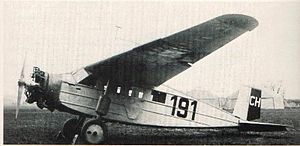- Messerschmitt M 18
-
M 18 Role Airliner National origin Germany Manufacturer Messerschmitt/BFW Designer Willy Messerschmitt First flight 1926 Primary user Nordbayerische Verkehrsflug Number built ca 24 The Messerschmitt M 18 (later also known as the BFW M 18) was an airliner produced in Germany in the late 1920s.[1][2]
Design and development
Designed at the request of Theodor Croneiss to supply his new airline venture which was to become Nordbayerische Verkehrsflug (NOBA),[3] it was a conventional high-wing cantilever monoplane with fixed tailskid undercarriage. The prototype was built of wood, although production examples would have a metal structure.[2] The design was praised in its day for the cleanness of its aerodynamics, lightness of construction, and economy of operation[4]
Operational history
The first M 18 to enter service with NOBA was provided by Messerschmitt in exchange for a 49% share of the new company, and on 26 July it began commercial flights.[5] NOBA's early successes enabled the company to place orders for additional examples of an improved model, the M 18b. It would eventually purchase twelve of these,[3] but manufacturing them would exceed the capacity of Messerschmitt's own small firm, leading to a merger with Bayerische Flugzeugwerke (BFW) in 1927. Following NOBA's reorganisation into DEVAG in 1931, a small number of a further improved version designated M 18d were ordered, but the type was soon superseded by the similar but larger Messerschmitt M 20.[2]
Variants
- M 18a - three-seat production version with 60 kW (80 hp)Siemens-Halske Sh 11 engine (2 built)
- M 18b - three/four-seat production version with 82 kW (110 hp) Siemens-Halske Sh 12 engine (12 built)
- M 18c - photographic survey version with 164 kW (220 hp) Armstrong Siddeley Lynx engine (2 or 3 built)
- M 18d - enlarged six/seven/eight-passenger version, produced with a variety of engines, including the Lynx, the 112 kW (150 hp) Walter Mars and the 240 kW (325 hp) Wright Whirlwind. (8 built)
Specifications (M 18b)
Data from The Illustrated Encyclopedia of Aircraft, 494. Weights from [6],
General characteristics
- Crew: 1, pilot
- Capacity: 3/4 passengers
- Length: 8.00 m (26 ft 3 in)
- Wingspan: 15.70 m (51 ft 6 in)
- Height: 2.50 m (8 ft 3 in)
- Wing area: 24.8 m2 (267 ft2)
- Empty weight: 480 kg (1,058 lb)
- Gross weight: 740 kg (1,632 lb)
- Powerplant: 1 × Siemens-Halske Sh 12, 82 kW (110 hp)
Performance
- Cruising speed: 140 km/h (87 mph)
- Range: 700 km (440 miles)
- Service ceiling: 2,700 m (8,900 ft)
Notes
References
- "1928 Berlin Aero Show". Flight: 907–22. 1928. http://www.flightglobal.com/pdfarchive/view/1928/1928%20-%200977.html. Retrieved 2008-10-24.
- Mulder, Rob. "Nordbayerischer Verkehrsflug GmbH - NOBA (1926-1931)". europeanairlines.no. http://www.europeanairlines.no/Arcticles_NOBA_101004.htm. Retrieved 2008-10-24.[dead link]
- Szigeti, Marton (July 1998). "Messerschmitt History: Civil Projects". Flug Revue. http://www.flug-revue.rotor.com/FRHEFT/FRH9807/FR9807d.htm. Retrieved 2008-10-24.
- Taylor, Michael J. H. (1989). Jane's Encyclopedia of Aviation. London: Studio Editions.
- The Illustrated Encyclopedia of Aircraft. London: Aerospace Publishing.
Messerschmitt aircraft Company designations RLM designations 1933-1945 Experimental designations USAAC designations Lists relating to aviation General Aircraft (manufacturers) · Aircraft engines (manufacturers) · Airlines (defunct) · Airports · Civil authorities · Museums · Registration prefixes · Rotorcraft (manufacturers) · TimelineMilitary Accidents/incidents Records Categories:- German airliners 1920–1929
- Messerschmitt aircraft
Wikimedia Foundation. 2010.

